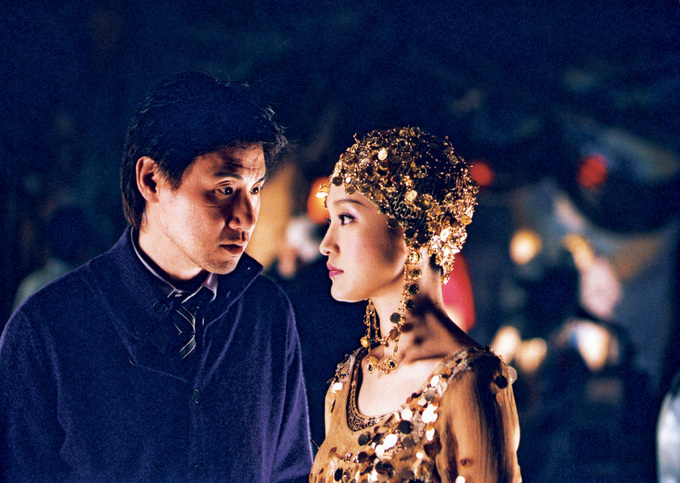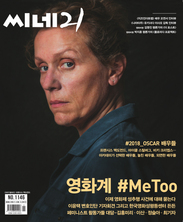왜 발리우드는 아시아에서 뮤지컬을 독보적으로 선점하고 있을까? 최근 케세이 클래식 필름 라이브러리에서 재발간된 수많은 DVD를 보다가 이중 여러 편이 뮤지컬인 것을 발견하곤 이런 생각이 들었다. 50년대 중반에서 70년대 초반, 만다린어영화에서 케세이는 쇼브러더스의 가장 큰 라이벌이었고, 그 기간 동안 케세이는 여배우 중심의 스튜디오로 유명해지면서 200편이 넘는 영화를 만들어냈다.
쇼브러더스 역시 같은 시기에 수많은 뮤지컬을 만들었다. 그러나 케세이의 뮤지컬들은 더 부드럽고 덜 가공된- 심지어 더 아마추어다운- 모습을 보여준다. 이 영화들은 아마도 호화로운 서구 스타일의 뮤지컬에 전혀 경험이 없었던 국내 감독들이 만들었을 것이다(할리우드 영향을 받은 스튜디오 시스템의 60년대 쇼브러더스 뮤지컬 스타일은 기본적으로 일본에서 데려온 이노우에 우메쓰구 감독이 만든 것이다). 인기 여배우 린다이위가 주연을 맡은 고아원을 배경으로 한 1959년작 <신데렐라와 작은 천사들>의 주목할 만한 예외가 있긴 하지만, 대부분 케세이 뮤지컬들은- 예로 학원코미디인 <맘보걸>(1957)이나 나이트클럽 드라마인 <들장미>(1960) 같은 고전물이 있고, 멋진 치아를 드러내며 웃어 보이는 여배우 그레이스 창이 두 영화 모두에 출연했지만- 노래가 플롯의 행동에서 나오거나 그것을 진전시키는 온전한 뮤지컬드라마라기보다 노래가 함께하는 코미디나 드라마였다. 전자의 형식은 본질적으로 40년대와 50년대 브로드웨이에서 개발한 서구의 창조물이다.
중국영화는 이런 장르의 역사가 없었다. 상하이 유성영화 초기 시절- 1937년작 <거리천사>에서 여가수 슈안이 노래를 부르면 애니메이션으로 만든 공이 화면에 나온 가사 위로 튕겨다닐 때- 이는 현대 가라오케를 정확히 예견한 것이었지만- 그 시절부터 중국 ‘뮤지컬’은 늘 막간에 노래가 나오는 드라마나 코미디 정도였다. 동아시아의 나머지 지역도 동일한 형식을 취했다. 그러나 인도는 달랐다. 30년대 인도 뮤지컬 역시 노래가 있는 화려한 쇼로 시작했다. 그렇지만 2차대전 뒤 브로드웨이나 할리우드의 영향이 아니라 드라마에 대한 자연스런 반응으로 점차 노래들이 이야기 전개와 융합되어갔다. 특히 비말 로이와 구루 더트 같은 감독들의 영화에서 그랬다. 70년대 이후 거대한 사실주의의 흐름이 세계 영화제작 대부분에 영향을 끼치기 시작할 때- 뮤지컬 같은 판타지 형식의 종말을 부르기도 했는데- 인도에서는 고대 그리스의 초기 드라마들과 마찬가지로 음악과 춤이 대사가 있는 드라마에서 비정상적인 종양이 아니라 자연스런 연장처럼 나오는 영화들이 제작됐다.
요즘 들어 발리우드 모방의 증가세가 보여주듯 전세계- 심지어 아시아의 나머지 지역도 동의하는 듯하다. 발리우드를 다채로운 캠프로 선전하는 경향이 있긴 하지만 말이다(분명 인도 관객에게는 적용되지 않는 생각이다).
유진위 감독의 최근작 <정전대성>(A Chinese Tall Story)에서 삼장은 “서방으로 여행(서유)” 중 짧은 발리우드식 노래와 춤으로 환영을 받는다. 성룡은 그 외에 지루했던 <신화: 진시황릉의 비밀>의 한 부분에 발리우드에 대한 오마주를 집어넣었다. 중국 뮤지컬의 가장 최근 시도로 진가신 감독의 <퍼햅스 러브>는 발리우드영화의 최고봉인 파라 칸이 안무를 맡기까지 했다.
그렇다면 인도 뮤지컬의 힘은 무엇인가? 이 장르가 여전히 번성하는 것은 ‘세련된’ 도시 중산층이 되지 못한 대규모의 지방 관객이 있기 때문인가? 그럴지도 모른다. 그렇지만 그건 사회학자들이나 문화사가들이 논쟁할 몫이다. 필자는 다만 인도업계가 이런 영화들을 계속해서 제작하는 것이 행복할 따름이다. 왜냐하면 최상급 발리우드영화가 와이드 스크린 뮤지컬 스펙터클을 펼쳐 보일 때보다 더 큰 아드레날린을 뿜는 쾌감을 주는 영화가 오늘날에도 여전히 없기 때문이다. “세이 ‘샤바샤바’할 사람 있나요?”
Why has Bollywood got the Asian monopoly on musicals?
The thought came to me recently when watching a large number of DVD reissues from the Cathay Classics Film Library, several of which were musicals. Cathay was Shaw Brothers' biggest rival in Mandarin cinema during the mid-'50s to early '70s, during which time it made over 200 movies, becoming especially famous as an actress-driven studio.
Shaw Brothers also made a lot of musicals during the same period but Cathay's have a softer, less processed - even more amateurish - look, perhaps from being directed by local directors with no experience in mounting lavish, western-style musicals. (The style of Shaws' Hollywood-influenced, studio-bound musicals of the '60s was basically invented by a a Japanese import, director Inoue Umetsugu.)
With the remarkable exception of the orphanage-set "Cinderella and Her Little Angels," shot in 1959 and starring diva Lin Dai, most of Cathay's musicals were comedies or dramas with songs - classics like the college comedy "Mambo Girl" (1957) or nightclub drama "Wild, Wild Rose" (1960), both starring toothy diva Grace Chang - rather than integrated musical dramas in which the songs sprung from or advanced the action. The latter form is essentially a western invention, as developed on Broadway during the '40s and '50s.
Chinese cinema had no history of such a genre. From the early days of Shanghai sound movies - when songstress Zhou Xuan sang in the 1937 "Street Angel," and an animated ball bounced across the on-screen lyrics, in an exact forecast of modern-day karaoke - a Chinese "musical" was always a comedy or drama with song interludes. The same went for the rest of East Asia as well.
Except in India. Indian musicals began during the '30s also as song extravaganzas, but after WW2 the songs became more integrated into the action, not from any Broadway or Hollywood influence but more as a natural response to the drama, especially in movies by directors like Bimal Roy and Guru Dutt. As greater realism started to infect much of the world's film production from the '70s onwards - and largely spelled the end of a fantasy form like the musical - India carried on producing films in which music and dance, as from the earliest dramas of Ancient Greece, is seen as a natural extension of spoken drama rather than some kind of abnormal growth.
Given the growing number of imitations nowadays, the rest of the world - and even the rest of Asia - seems to agree, even if they tend to play up Bollywood more as colorful camp. (For Indian viewers, it decidedly is not).
In Jeff Lau's recent "A Chinese Tall Story," Tripitaka is welcomed during his "Journey to the West" by a brief Bollywood song-and-dance; Jackie Chan made a nod to Bollywood during one section of his otherwise dreary "The Myth"; and the latest attempt at an integrated Chinese musical, Peter Chan's "Perhaps Love," was even choreographed by Farah Khan, one of Bollywood's best.
So what's India's musical mojo? Does the genre still thrive there because there's still a massive rural audience that hasn't been turned into a "sophisticated" urban middle class? Well, maybe - but that's for sociologists and cultural historians to argue over.
I'm just happy that Indian cinema keeps on producing these films, as there's still no greater adrenalin-rush in movies today than when a top-class Bollywood movie launches into a widescreen musical spectacular. "Say 'shava-shava,'" anyone?


